-
27 Apr 2024
A Comic book titled “Let’s Move Forward” launched by the NCERT in collaboration with UNESCO, New Delhi
A Comic book titled “Let’s Move Forward” launched by the NCERT in collaboration with UNESCO, New Delhi.
-
24 Jul 2023
Indian Scientists Develop Super-Flexible Composite Semiconductors.

The composite semiconductor is made up of two materials a water-insoluble polymer such as ethyl cellulose that provides flexibility, and indium oxide, a semiconductor which brings in excellent electronic transport properties.
Scientists at the Indian Institute of Science (IISc) have developed a super flexible, composite semiconductor material that can have possible applications in next-generation flexible or curved displays, foldable phones and wearable electronics.
The composite semiconductor is made up of two materials – a water-insoluble polymer such as ethyl cellulose that provides flexibility, and indium oxide, a semiconductor which brings in excellent electronic transport properties.
To design the material, the researchers mixed the polymer with the oxide precursor in such a way that interconnected oxide nanoparticle channels are formed (around phase-separated polymer islands) through which electrons can move from one end of a transistor (source) to the other (drain), ensuring a steady current flow.
The key to form these connected pathways, the researchers found, was the choice of the right kind of water-insoluble polymer that does not mix with the oxide lattice when the oxide semiconductor is being fabricated. -
15 Jul 2023
चंद्रयान-3
चंद्रयान-3 चंद्रयान-2 का अनुवर्ती मिशन है, जो चंद्र सतह पर सुरक्षित लैंडिंग और रोविंग की एंड-टू-एंड क्षमता प्रदर्शित करता है। इसमें लैंडर और रोवर विन्यास शामिल हैं। इसे एलवीएम3 द्वारा एसडीएससी शार, श्रीहरिकोटा से 14 जुलाई 2023 को प्रमोचित किया गया। प्रणोदन मॉड्यूल 100 किमी चंद्र कक्षा तक लैंडर और रोवर विन्यास को ले जाएगा। प्रणोदन मॉड्यूल में चंद्र कक्षा से पृथ्वी के वर्णक्रमीय और ध्रुवीय मीट्रिक मापों का अध्ययन करने के लिए स्पेक्ट्रो-पोलरिमेट्री ऑफ हैबिटेबल प्लैनेट अर्थ (एसएचएपीई) नीतभार है।
लैंडर नीतभार: तापीय चालकता और तापमान को मापने के लिए चंद्र सतह तापभौतिकीय प्रयोग (चेस्ट); लैंडिंग साइट के आसपास भूकंपीयता को मापने के लिए चंद्र भूकंपीय गतिविधि (आईएलएसए) के लिए साधनभूत; प्लाज्मा घनत्व और इसकी विविधताओं का अनुमान लगाने के लिए लैंगमुइर जांच (एलपी)। नासा से एक निष्क्रिय लेजर रिट्रोरिफ्लेक्टर ऐरे को चंद्र लेजर रेंजिंग अध्ययनों के लिए समायोजित किया गया है।
रोवर नीतभार: लैंडिंग साइट के आसपास मौलिक संरचना प्राप्त करने के लिए अल्फा कण एक्स-रे स्पेक्ट्रोमीटर (एपीएक्सएस) और लेजर प्रेरित ब्रेकडाउन स्पेक्ट्रोस्कोप (एलआईबीएस)।
चंद्रयान-3 में एक स्वदेशी लैंडर मॉड्यूल (एलएम), प्रोपल्शन मॉड्यूल (पीएम) और एक रोवर शामिल है, जिसका उद्देश्य अंतरग्रहीय मिशनों के लिए आवश्यक नई तकनीकों को विकसित और प्रदर्शित करना है। लैंडर के पास निर्दिष्ट चंद्र स्थल पर सॉफ्ट लैंड करने और रोवर को तैनात करने की क्षमता होगी जो इसकी गतिशीलता के दौरान चंद्र सतह के इन-सीटू रासायनिक विश्लेषण करेगा। लैंडर और रोवर के पास चंद्र सतह पर प्रयोग करने के लिए वैज्ञानिक नीतभार हैं। पीएम का मुख्य कार्य एलएम को लॉन्च व्हीकल इंजेक्शन से अंतिम चंद्र 100 किमी गोलाकार ध्रुवीय कक्षा तक ले जाना और एलएम को पीएम से अलग करना है। इसके अलावा, प्रणोदन मॉड्यूल में मूल्यवर्धन के रूप में एक वैज्ञानिक नीतभार भी है जिसे लैंडर मॉड्यूल के अलग होने के बाद संचालित किया जाएगा। चंद्रयान-3 के लिए चिन्हित किया गया लॉन्चर जीएसएलवी-एमके3 है जो एकीकृत मॉड्यूल को ~170x36500 किमी आकार के एलिप्टिक पार्किंग ऑर्बिट (ईपीओ) में स्थापित करेगा।
चंद्रयान-3 के मिशन के उद्देश्य हैं:
- चंद्र सतह पर सुरक्षित और सॉफ्ट लैंडिंग प्रदर्शित करना
- रोवर को चंद्रमा पर भ्रमण का प्रदर्शन करना और
- यथास्थित वैज्ञानिक प्रयोग करना
मिशन के उद्देश्यों को प्राप्त करने के लिए लैंडर में कई उन्नत प्रौद्योगिकियां मौजूद हैं जैसे,
- अल्टीमीटर: लेजर और आरएफ आधारित अल्टीमीटर
- वेलोसीमीटर : लेजर डॉपलर वेलोसीमीटर और लैंडर हॉरिजॉन्टल वेलोसिटी कैमरा
- जड़त्वीय मापन: लेजर गायरो आधारित जड़त्वीय संदर्भ और एक्सेलेरोमीटर पैकेज
- प्रणोदन प्रणाली: 800N थ्रॉटलेबल लिक्विड इंजन, 58N एटिट्यूड थ्रस्टर्स और थ्रॉटलेबल इंजन कंट्रोल इलेक्ट्रॉनिक्स
- नौवहन, गाइडेंस एंड कंट्रोल (NGC): पावर्ड डिसेंट ट्रैजेक्टरी डिजाइन और सहयोगी सॉफ्टवेयर तत्व
- खतरे का पता लगाना और बचाव : लैंडर खतरे का पता लगाना और बचाव कैमरा और प्रसंस्करण एल्गोरिथम
- लैंडिंग लेग तंत्र
उपर्युक्त उन्नत तकनीकों को पृथ्वी की स्थिति में प्रदर्शित करने के लिए, कई लैंडर विशेष परीक्षणों की योजना बनाई गई है और सफलतापूर्वक संपन्न किए गए हैं।
- एकीकृत शीत परीक्षण - परीक्षण प्लेटफॉर्म के रूप में हेलीकॉप्टर का उपयोग करके एकीकृत संवेदक और नौवहन प्रदर्शन परीक्षण का प्रदर्शन
- एकीकृत हॉट परीक्षण - टॉवर क्रेन का परीक्षण प्लेटफॉर्म के रूप में उपयोग करके संवेदक, एक्चुएटर्स और एनजीसी के साथ बंद लूप प्रदर्शन परीक्षण का प्रदर्शन
- लैंडर लेग मैकेनिज्म परफॉरमेंस परीक्षण एक लूनर सिमुलेंट परीक्षण बेड पर विभिन्न टच डाउन स्थितियों का अनुकरण करता है।
चंद्रयान -3 के लिए समग्र विनिर्देश नीचे दिए गए हैं:
क्र सं. प्राचल विशेष विवरण 1. मिशन लाइफ (लैंडर और रोवर) एक चंद्र दिवस (~14 पृथ्वी दिवस) 2. लैंडिंग साइट (प्राइम) 4 किमी x 2.4 किमी 69.367621 द., 32.348126 पू. 3. विज्ञान नीतभार लैंडर: - मून बाउंड हाइपरसेंसिटिव आयनोस्फीयर और एटमॉस्फियर (रंभा) की रेडियो एनाटॉमी
- चंद्र का सरफेस थर्मो फिजिकल एक्सपेरिमेंट (चेस्ट)
- चंद्र भूकंपीय गतिविधि के लिए उपकरण (ILSA)
- लेजर रेट्रोरिफ्लेक्टर ऐरे (एलआरए) रोवर:
- अल्फा कण एक्स-रे स्पेक्ट्रोमीटर (एपीएक्सएस)
- लेजर प्रेरित ब्रेकडाउन स्पेक्ट्रोस्कोप (एलआईबीएस) प्रणोदन मॉड्यूल:
- निवासयोग्यग्रह पृथ्वी (शेप) की स्पेक्ट्रो-ध्रुवीयमिति
4. दो मॉड्यूल विन्यास - प्रणोदन मॉड्यूल (लैंडर को प्रमोचन प्रवेशन से चंद्र कक्षा तक ले जाता है)
- लैंडर मॉड्यूल (रोवर को लैंडर के अंदर समायोजित किया गया है)
5. द्रव्यमान - प्रणोदन मॉड्यूल: 2148 किग्रा
- लैंडर मॉड्यूल: 26 किलो के रोवर सहित 1752 किलो
- कुल: 3900 किग्रा
6. विद्युत उत्पादन - प्रणोदन मॉड्यूल: 758 W
- लैंडर मॉड्यूल: 738W, डब्ल्यूएस बायस के साथ
- रोवर: 50W
7. संचार - प्रणोदन मॉड्यूल: आईडीएसएन के साथ संचार करता है
- लैंडर मॉड्यूल: आईडीएसएन और रोवर के साथ संचार करता है। आकस्मिक लिंक के लिए चंद्रयान -2 कक्षित्र की भी योजना है।
- रोवर: लैंडर के साथ ही संचार करता है।
8. लैंडर संवेदक - लेजर जड़त्वीय संदर्भ और त्वरणमापी पैकेज (एलआईआरएपी)
- केए-बैंड अल्टीमीटर (कारा)
- लैंडर पोजीशन डिटेक्शन कैमरा (एलपीडीसी)
- एलएचडीएसी (लैंडर हैज़र्ड डिटेक्शन एंड अवॉइडेंस कैमरा)
- लेजर अल्टीमीटर (एलएएसए)
- लेजर डॉप्लर वेलोसीमीटर (एलडीवी)
- लैंडर क्षैतिज वेग कैमरा (एलएचवीसी)
- माइक्रो स्टार संवेदक
- इनक्लिनोमीटर और टचडाउन संवेदक
9. लैंडर एक्ट्यूएटर्स प्रतिक्रिया व्हील - 4 नग (10 एनएम और 0.1 एनएम) 10. लैंडर प्रणोदन प्रणाली द्वि-प्रणोदक प्रणोदन प्रणाली (एमएमएच + एमओएन3), 4 नग, 800 एन थ्रॉटलेबल इंजन और 8 नग. 58 एन; थ्रॉटलेबल इंजन कंट्रोल इलेक्ट्रॉनिक्स 11. लैंडर तंत्र - लैंडर लेग
- रोवर रैंप (प्राथमिक और द्वितीयक)
- रोवर
- आईएलएसए, रंभा और चैस्ट नीतभार
- गर्भनाल संबंधक संरक्षण तंत्र,
- एक्स-बैंड एंटीना
12. लैंडर सतहस्पर्श विनिर्देश - लंबवत वेग: ≤ 2 मीटर / सेकंड
- क्षैतिज वेग: ≤ 0.5 मीटर / सेकंड
- ढलान: ≤ 120
चंद्रयान-3 लैंडर मॉड्यूल और रोवर पर नियोजित वैज्ञानिक नीतभार के उद्देश्य नीचे दिए गए हैं:
क्र.सं. लैंडर नीतभार उद्देश्य 1. मून बाउंड हाइपरसेंसिटिव आयनोस्फीयर और एटमॉस्फियर (रंभा) की रेडियो एनाटॉमी लैंगमुइर जांच (एलपी) निकट सतह प्लाज्मा (आयन और इलेक्ट्रॉन) घनत्व और समय के साथ इसके परिवर्तन को मापने के लिए 2. चंद्रा का सरफेस थर्मो फिजिकल एक्सपेरिमेंट (चास्टे) ध्रुवीय क्षेत्र के निकट चंद्र सतह के तापीय गुणों का मापन करना। 3. चंद्र भूकंपीय गतिविधि के लिए साधन (आईएलएसए) लैंडिंग साइट के आसपास भूकंपीयता को मापने और चंद्र क्रस्ट और मेंटल की संरचना को चित्रित करने के लिए। 4. लेजर रिट्रोरिफ्लेक्टर ऐरे (एलआरए) यह चंद्र प्रणाली की गतिकी को समझने के लिए एक परक्रिय प्रयोग है। क्र.सं. रोवर नीतभार उद्देश्य 1. लेजर प्रेरित ब्रेकडाउन स्पेक्ट्रोस्कोप (एलआईबीएस) गुणात्मक और मात्रात्मक तात्विक विश्लेषण और चंद्र-सतह की हमारी समझ को आगे बढ़ाने के लिए रासायनिक संरचना और खनिज संरचना का अनुमान लगाना। 2. अल्फा कण एक्स-रे स्पेक्ट्रोमीटर (एपीएक्सएस) मौलिक संरचना (एमजी, अल, सी, के, सीए, टीआई, फे) निर्धारित करना। क्र.सं. प्रणोदन मॉड्यूल नीतभार उद्देश्य 1. निवासयोग्यग्रह पृथ्वी (शेप) की स्पेक्ट्रो-ध्रुवीयमिति परावर्तित प्रकाश में छोटे ग्रहों की भविष्य की खोजों से हमें विभिन्न प्रकार के एक्सो -प्लैनेट्स की जांच करने की अनुमति मिलेगी जो कि निवासयोग्य (या जीवन की उपस्थिति के लिए) योग्य होंगे। चंद्रयान-3 मॉड्यूल के तीन आयामी झलक नीचे दी गईं हैं:
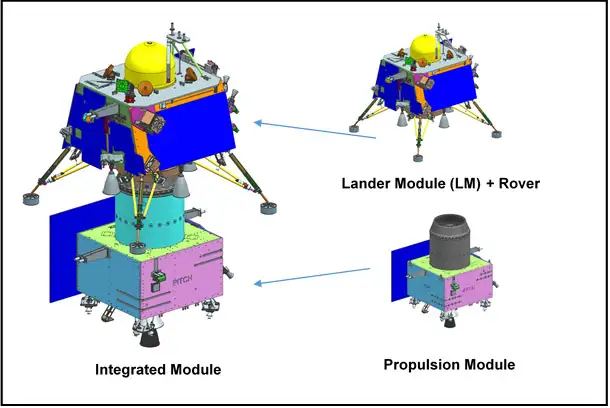
चंद्रयान -3 – तत्त्व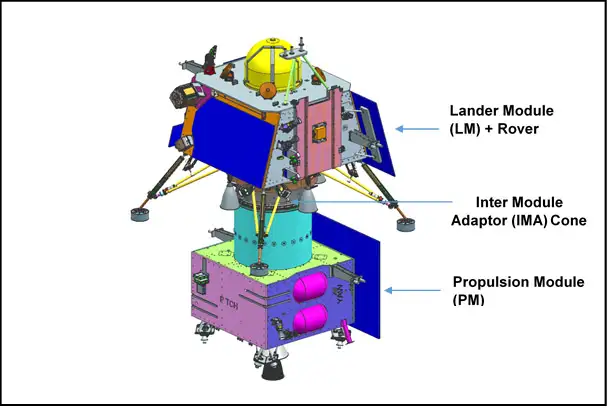
चंद्रयान -3 - एकीकृत मॉड्यूल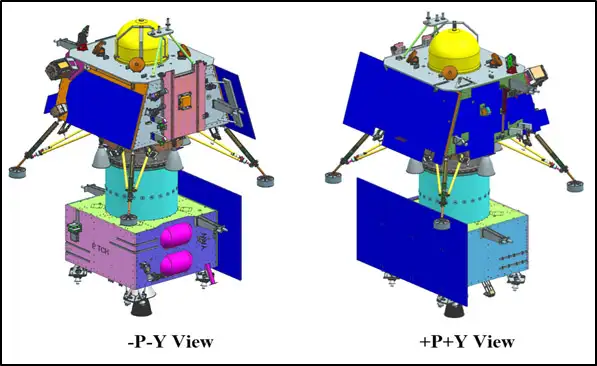
चंद्रयान -3 एकीकृत मॉड्यूल – दृश्य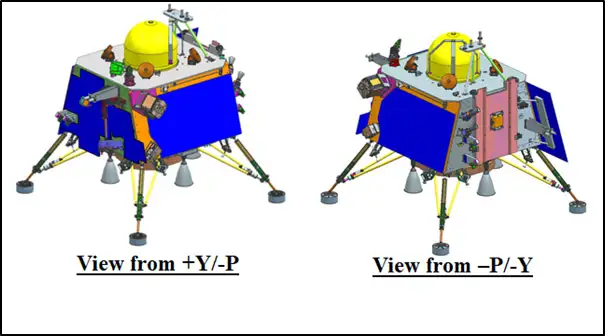
चंद्रयान-3 लैंडर मॉड्यूल –दृश्य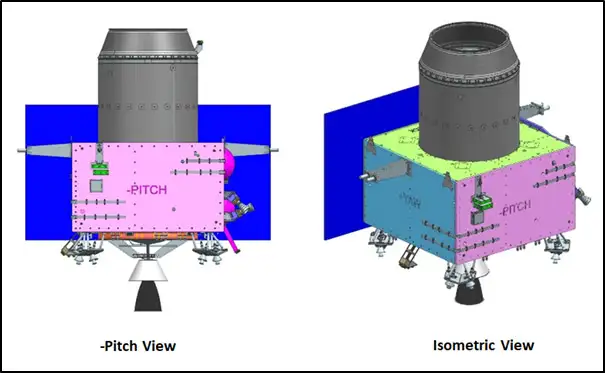
चंद्रयान-3 प्रणोदन मॉड्यूल – दृश्य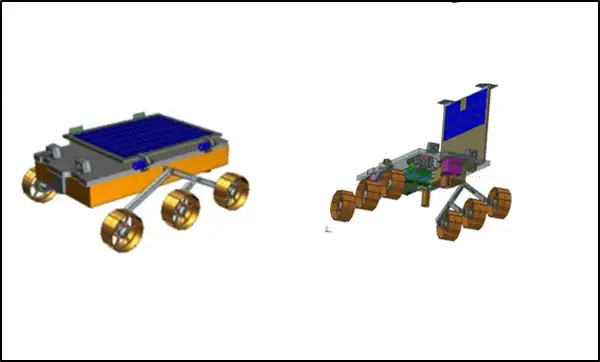
रैंप पर चंद्रयान -3 रोवर और तैनात दृश्य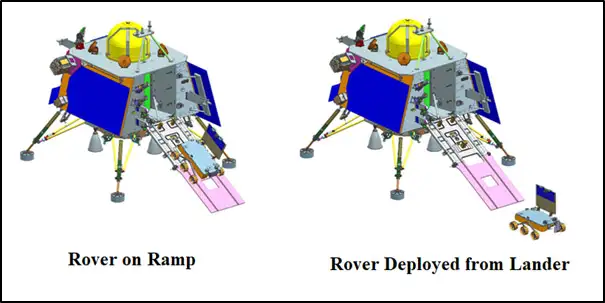
चंद्रयान -3 रोवर –दृश्य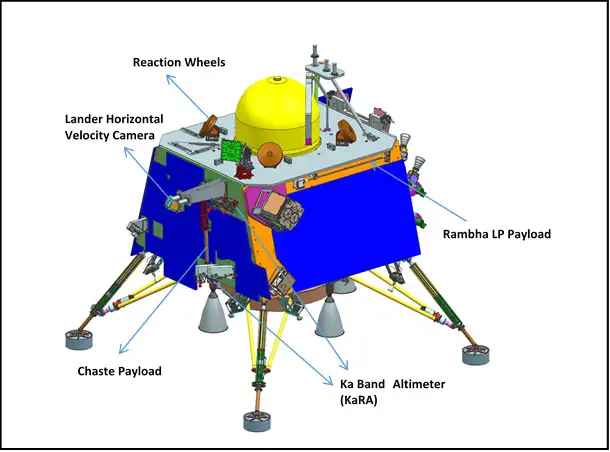
चंद्रयान-3 लैंडर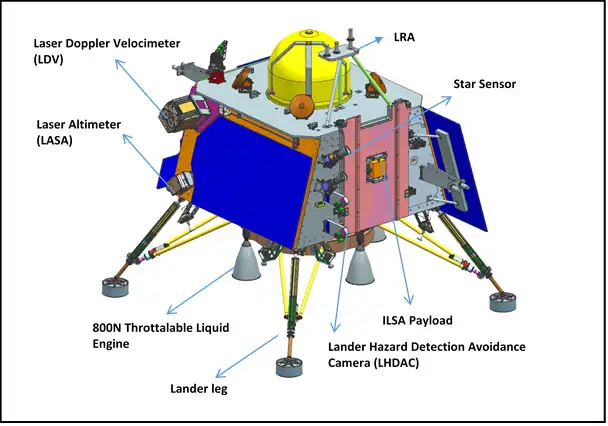
चंद्रयान-3 लैंडर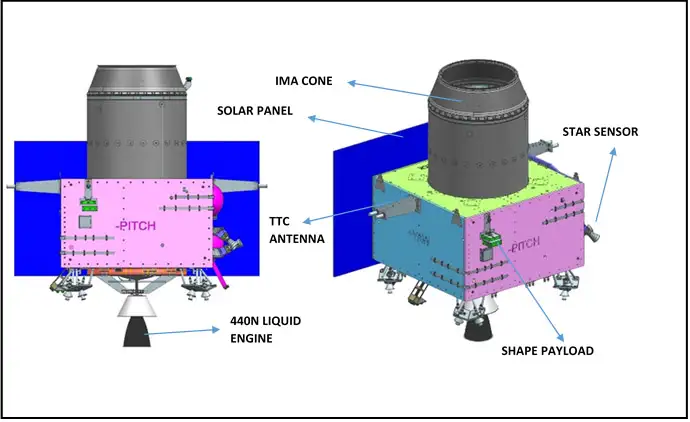
चंद्रयान -3 प्रणोदन मॉड्यूल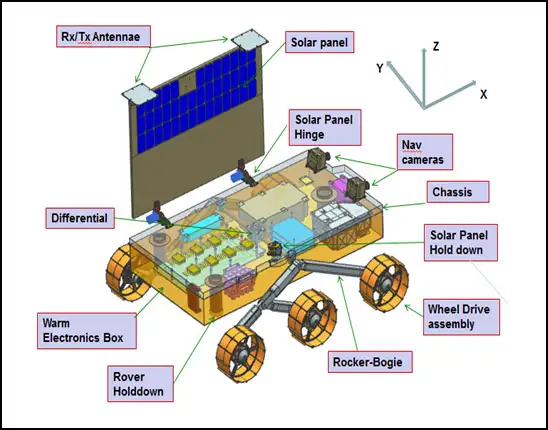
चंद्रयान-3 रोवर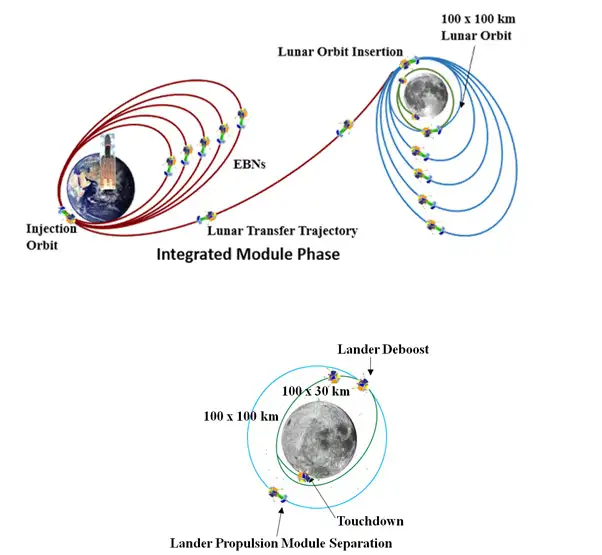
चंद्रयान-3 - मिशन प्रोफाइल -
15 Jul 2023
CHANDRAYAAN - 3
Chandrayaan-3
Chandrayaan-3 is a follow-on mission to Chandrayaan-2 to demonstrate end-to-end capability in safe landing and roving on the lunar surface. It consists of Lander and Rover configuration. It has been launched by LVM3 from SDSC SHAR, Sriharikota on 14th July 2023. The propulsion module will carry the lander and rover configuration till 100 km lunar orbit. The propulsion module has Spectro-polarimetry of Habitable Planet Earth (SHAPE) payload to study the spectral and Polari metric measurements of Earth from the lunar orbit.
Lander payloads: Chandra’s Surface Thermophysical Experiment (ChaSTE) to measure the thermal conductivity and temperature; Instrument for Lunar Seismic Activity (ILSA) for measuring the seismicity around the landing site; Langmuir Probe (LP) to estimate the plasma density and its variations. A passive Laser Retroreflector Array from NASA is accommodated for lunar laser ranging studies.
Rover payloads: Alpha Particle X-ray Spectrometer (APXS) and Laser Induced Breakdown Spectroscope (LIBS) for deriving the elemental composition in the vicinity of landing site.
Chandrayaan-3 consists of an indigenous Lander module (LM), Propulsion module (PM) and a Rover with an objective of developing and demonstrating new technologies required for Inter planetary missions. The Lander will have the capability to soft land at a specified lunar site and deploy the Rover which will carry out in-situ chemical analysis of the lunar surface during the course of its mobility. The Lander and the Rover have scientific payloads to carry out experiments on the lunar surface. The main function of PM is to carry the LM from launch vehicle injection till final lunar 100 km circular polar orbit and separate the LM from PM. Apart from this, the Propulsion Module also has one scientific payload as a value addition which will be operated post separation of Lander Module. The launcher identified for Chandrayaan-3 is GSLV-Mk3 which will place the integrated module in an Elliptic Parking Orbit (EPO) of size ~170 x 36500 km.
The mission objectives of Chandrayaan-3 are:
- To demonstrate Safe and Soft Landing on Lunar Surface
- To demonstrate Rover roving on the moon and
- To conduct in-situ scientific experiments.
To achieve the mission objectives, several advanced technologies are present in Lander such as,
- Altimeters: Laser & RF based Altimeters
- Velocimeters: Laser Doppler Velocimeter & Lander Horizontal Velocity Camera
- Inertial Measurement: Laser Gyro based Inertial referencing and Accelerometer package
- Propulsion System: 800N Throttleable Liquid Engines, 58N attitude thrusters & Throttleable Engine Control Electronics
- Navigation, Guidance & Control (NGC): Powered Descent Trajectory design and associate software elements
- Hazard Detection and Avoidance: Lander Hazard Detection & Avoidance Camera and Processing Algorithm
- Landing Leg Mechanism.
To demonstrate the above said advanced technologies in earth condition, several Lander special tests have been planned and carried out successfully viz.
- Integrated Cold Test - For the demonstration of Integrated Sensors & Navigation performance test using helicopter as test platform
- Integrated Hot test – For the demonstration of closed loop performance test with sensors, actuators and NGC using Tower crane as test platform
- Lander Leg mechanism performance test on a lunar simulant test bed simulating different touch down conditions.
The overall specifications for Chandrayaan-3 is provided below:
Sl No. Parameter Specifications 1. Mission Life (Lander & Rover) One lunar day (~14 Earth days) 2. Landing Site (Prime) 4 km x 2.4 km 69.367621 S, 32.348126 E 3. Science Payloads Lander: - Radio Anatomy of Moon Bound Hypersensitive ionosphere and Atmosphere (RAMBHA)
- Chandra’s Surface Thermo physical Experiment (ChaSTE)
- Instrument for Lunar Seismic Activity (ILSA)
- Laser Retroreflector Array (LRA) Rover:
- Alpha Particle X-Ray Spectrometer (APXS)
- Laser Induced Breakdown Spectroscope (LIBS) Propulsion Module:
- Spectro-polarimetry of HAbitable Planet Earth (SHAPE)
4. Two Module Configuration - Propulsion Module (Carries Lander from launch injection to Lunar orbit)
- Lander Module (Rover is accommodated inside the Lander)
5. Mass - Propulsion Module: 2148 kg
- Lander Module: 1752 kg including Rover of 26 kg
- Total: 3900 kg
6. Power generation - Propulsion Module: 758 W
- Lander Module: 738W, WS with Bias
- Rover: 50W
7. Communication - Propulsion Module: Communicates with IDSN
- Lander Module: Communicates with IDSN and Rover. Chandrayaan-2 Orbiter is also planned for contingency link.
- Rover: Communicates only with Lander.
8. Lander Sensors - Laser Inertial Referencing and Accelerometer Package (LIRAP)
- Ka-Band Altimeter (KaRA)
- Lander Position Detection Camera (LPDC)
- LHDAC (Lander Hazard Detection & Avoidance Camera)
- Laser Altimeter (LASA)
- Laser Doppler Velocimeter (LDV)
- Lander Horizontal Velocity Camera (LHVC)
- Micro Star sensor
- Inclinometer & Touchdown sensors
9. Lander Actuators Reaction wheels – 4 nos (10 Nms & 0.1 Nm) 10. Lander Propulsion System Bi-Propellant Propulsion System (MMH + MON3), 4 nos. of 800 N Throttleable engines & 8 nos. of 58 N; Throttleable Engine Control Electronics 11. Lander Mechanisms - Lander leg
- Rover Ramp (Primary & Secondary)
- Rover
- ILSA, Rambha & Chaste Payloads
- Umbilical connector Protection Mechanism,
- X- Band Antenna
12. Lander Touchdown specifications - Vertical velocity: ≤ 2 m / sec
- Horizontal velocity: ≤ 0.5 m / sec
- Slope: ≤ 120
The objectives of scientific payloads planned on Chandrayaan-3 Lander Module and Rover are provided below:
Sl. No Lander Payloads Objectives 1. Radio Anatomy of Moon Bound Hypersensitive ionosphere and Atmosphere (RAMBHA) Langmuir probe (LP) To measure the near surface plasma (ions and electrons) density and its changes with time 2. Chandra’s Surface Thermo physical Experiment (ChaSTE) To carry out the measurements of thermal properties of lunar surface near polar region. 3. Instrument for Lunar Seismic Activity (ILSA) To measure seismicity around the landing site and delineating the structure of the lunar crust and mantle. 4. LASER Retroreflector Array (LRA) It is a passive experiment to understand the dynamics of Moon system. Sl. No Rover Payloads Objectives 1. LASER Induced Breakdown Spectroscope (LIBS) Qualitative and quantitative elemental analysis & To derive the chemical Composition and infer mineralogical composition to further our understanding of Lunar-surface. 2. Alpha Particle X-ray Spectrometer (APXS) To determine the elemental composition (Mg, Al, Si, K, Ca,Ti, Fe) of Lunar soil and rocks around the lunar landing site. Sl. No Propulsion Module Payload Objectives 1. Spectro-polarimetry of HAbitable Planet Earth (SHAPE) Future discoveries of smaller planets in reflected light would allow us to probe into variety of Exo-planets which would qualify for habitability (or for presence of life). Three dimensional views of Chandrayaan-3 modules are provided below:

Chandrayaan-3 – Elements
Chandrayaan-3 – Integrated Module
Chandrayaan-3 Integrated Module - Views
Chandrayaan-3 Lander Module -Views
Chandrayaan-3 Propulsion Module - Views
Chandrayaan-3 Rover on Ramp and Deployed Views
Chandrayaan-3 Rover -Views
Chandrayaan-3 Lander
Chandrayaan-3 Lander
Chandrayaan-3 Propulsion Module
Chandrayaan-3 Rover
Chandrayaan-3 – Mission Profile
-
11 Mar 2020
CORONA COMIC
This comic strip has been prepared by the Ministry of Health, Government of India
All the parents and citizens are requested to disseminate it widely amongst your children and society.
Regards
IT Department
S.C.B. ACADEMY
Nathuwawala, Dehradun
-
15 Nov 2019
Book List 2019-20
-
15 Oct 2019
Book List Certificate 2019 - 20
-
23 Oct 2018
75th Anniversary of Azad Hind Government
Lets Salute to the Martyrs on the occassion of 75th Anniversary of Azad Hind Government.
-
01 Oct 2018
School Book List Certificate (2018 -19)
-
22 Sep 2018
Book List in School for the session 2018 - 19
News & Events
Circular & Downloads
